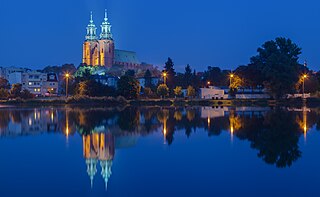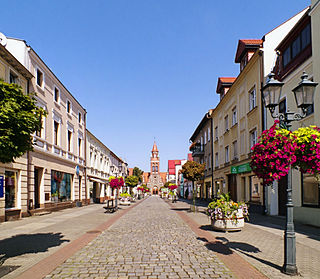Below is a list of museums in Poznań , Poland.
Contents

Below is a list of museums in Poznań , Poland.





Greater Poland Voivodeship is a voivodeship, or province, in west-central Poland. The province is named after the region called Greater Poland or Wielkopolska. The modern province includes most of this historic region, except for some western and northern parts.

Gniezno is a city in central-western Poland, about 50 kilometres east of Poznań. Its population in 2021 was 66,769, making it the sixth-largest city in the Greater Poland Voivodeship. One of the Piast dynasty's chief cities, it was the first historical capital of Poland in the 10th century and early 11th century, and it was mentioned in 10th-century sources, possibly including the Dagome Iudex, as the capital of Piast Poland.

The Greater Poland uprising of 1918–1919, or Wielkopolska uprising of 1918–1919 or Poznań War was a military insurrection of Poles in the Greater Poland region against German rule. The uprising had a significant effect on the Treaty of Versailles, which granted a reconstituted Second Polish Republic the area won by the Polish insurrectionists. The region had been part of the Kingdom of Poland and then Polish–Lithuanian Commonwealth before the 1793 Second Partition of Poland when it was annexed by the German Kingdom of Prussia. It had also, following the 1806 Greater Poland uprising, been part of the Duchy of Warsaw (1807–1815), a French client state during the Napoleonic Wars.

Środa Wielkopolska is a town in western-central Poland, situated in the Greater Poland Voivodeship, about 30 kilometres (19 mi) southeast of Poznań, with 22,001 inhabitants (2009). It is the seat of Środa Wielkopolska County, and of Gmina Środa Wielkopolska.

Jarocin is a town in west-central Poland with 25,700 inhabitants (1995), the administrative capital of Jarocin County in Greater Poland Voivodeship.

Gostyń is a town in western Poland, seat of the Gostyń County and Gmina Gostyń in the Greater Poland Voivodeship. According to 31 December 2023 data its population was 27,846.

Śrem is a town on the Warta river in central Poland. It is the seat of Śrem County in the Greater Poland Voivodeship. As of 1995, the population of Śrem was 29,800.

Grodzisk Wielkopolski is a town in western Poland, in Greater Poland Voivodeship (Wielkopolskie), with a population of 13,703 (2006). It is 43 kilometres (27 mi) south-west of Poznań, the voivodeship capital. It is the seat of Grodzisk Wielkopolski County, and also of the smaller administrative district called Gmina Grodzisk Wielkopolski. It is situated on the Letnica River. The suffix "Wielkopolski" distinguishes it from the town of Grodzisk Mazowiecki in east-central Poland.
The 1794 Greater Poland uprising was a military insurrection by Poles in Wielkopolska against Kingdom of Prussia which had taken possession of this territory after the 1793 Second Partition of the Polish–Lithuanian Commonwealth.

Wielkopolska National Park, also known as Wielkopolski National Park or Greater Poland National Park or the National Park of Greater Poland, is a National Park within the Wielkopolska region of west-central Poland, about 15 km (9 mi) south of the regional capital, Poznań. It gets its unique nature from post-glacial lakes surrounded by dense forests. Together with its protective zone, it includes part of the Poznań Lakeland and parts of Poznań's Warta Gorge.

Oborniki is a town in west-central Poland, in Greater Poland Voivodeship, about 30 km (19 mi) north of Poznań. It is the capital of Oborniki County and of Gmina Oborniki. Its population is 18,176 (2005).
Gronówko is a village in the administrative district of Gmina Lipno, within Leszno County, Greater Poland Voivodeship, in west-central Poland. It lies approximately 5 kilometres (3 mi) south-east of Lipno, 5 km (3 mi) north-east of Leszno, and 62 km (39 mi) south of the regional capital Poznań.
Kijewo is a village in the administrative district of Gmina Środa Wielkopolska, within Środa Wielkopolska County, Greater Poland Voivodeship, in west-central Poland. It lies approximately 4 kilometres (2 mi) south of Środa Wielkopolska and 34 km (21 mi) south-east of the regional capital Poznań.

Koszuty is a village in the administrative district of Gmina Środa Wielkopolska, within Środa Wielkopolska County, Greater Poland Voivodeship, in west-central Poland. It lies approximately 6 kilometres (4 mi) west of Środa Wielkopolska and 27 km (17 mi) south-east of the regional capital Poznań.
Bukowiec is a village in the administrative district of Gmina Wągrowiec, within Wągrowiec County, Greater Poland Voivodeship, in west-central Poland. It lies approximately 9 kilometres (6 mi) north-east of Wągrowiec and 57 km (35 mi) north-east of the regional capital Poznań.

Nadarzyce is a village in the administrative district of Gmina Jastrowie, within Złotów County, Greater Poland Voivodeship, in west-central Poland. It lies approximately 22 kilometres (14 mi) west of Jastrowie, 39 km (24 mi) west of Złotów, and 122 km (76 mi) north of the regional capital Poznań.

The Royal-Imperial Route in Poznań is a tourist walk running through the most important parts of the city and presenting the history, culture and identity of Poznań. The Route leads in a westward direction, from The Church of St. John Jerusalem behind the Wall to the Church of the Sacred Heart of Jesus and St. Florian.

Fort VII, officially Konzentrationslager Posen, was a Nazi German death camp set up in Poznań in German-occupied Poland during World War II, located in one of the 19th-century forts circling the city. According to different estimates, between 4,500 and 20,000 people, mostly Poles from Poznań and the surrounding region, died while imprisoned at the camp.

Greater Poland, often known by its Polish name Wielkopolska, is a Polish historical region of west-central Poland. Its chief and largest city is Poznań followed by Kalisz, the oldest city in Poland.

Wielkopolska Museum of Independence is a museum, a local cultural institution organized by the city of Poznań. The scope of the museum's activities includes collecting and making available collections on the independence uprisings and organic work during the partitions, the period of the Second Republic of Poland, fighting and martyrdom during World War II, as well as protests and opposition activities in the years 1945-1989. Before the name was changed, the museum was known as the Wielkopolska Museum of the Fight for Independence.
{{cite book}}: CS1 maint: location missing publisher (link)